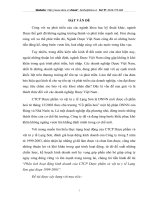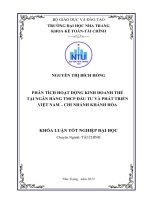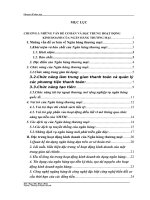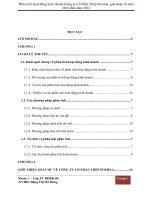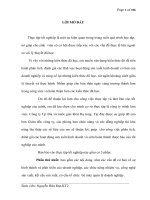Phân tích hoạt động kinh doanh thẻ giai dd 2006 2009 và xây dựng chiến lược kinh doanh thẻ giai đoạn 2010 2015 của ngân hàng BIDV
Bạn đang xem bản rút gọn của tài liệu. Xem và tải ngay bản đầy đủ của tài liệu tại đây (612.41 KB, 82 trang )
– Group No. 4
LUẬN VĂN THẠC SĨ
Phân tích hoạt động kinh doanh thẻ giai đoain 2006-2009 và xây dựng chiến
lược kinh doanh thẻ giai đoạn 2010-2015 của ngân hàng BIDV
THESIS TITLE
TOPIC: The analysis of card business operations during the 2006 – 2009
period at Bank for Investment and Development of Vietnam (BIDV) and
establishment of card business strategy for the 2010 – 2015 period.
Strategic Management
1
– Group No. 4
CONTENTS
Page
List of tables and index
6
INTRODUCTION
8
CHAPTER I: RATIONALE
10
1.1 Overview of card and card business at Commercial Banks
10
1.1.1 Overview of Card
10
1.1.2 Card classification
10
1.1.3 Card business at commercial banks
13
1.2 Business strategy
14
1.2.1 Concepts
14
1.2.2 Process of business strategy establishment
14
1.2.2.1 Vision of missions and values
14
1.2.2.2 Analysis of business environment
Macro-environment
15
Industry environment (the M. Porter 5 competitive
force model)
15
1.2.2.3 Analysis of internal environment
Determination of core internal factors
Performance of internal estimation
15
15
16
1.2.2.4 SWOT analysis
16
1.2.3 Selected business strategies
18
1.2.4 Organization of business strategies performance (the
functional strategy execution)
18
1.2.5 Estimation of business strategies
18
CHAPTER II: ANALYZING THE REAL SITUATION OF
CARD BUSINESS ACTIVITIES IN BIDV IN THE PERIOD
Strategic Management
2
– Group No. 4
BETWEEN 2006 - 2009
20
2.1 About Bank for Investment and Development of Vietnam
(BIDV)
20
2.2 The retail banking operation at BIDV
23
2.3 The real situation of card business operations at BIDV
25
2.3.1 Card business activities in Vietnam market
2.3.1.1
Result of card business activities in Vietnam market
2.3.1.2
The main characteristics of the card market Vietnam
2.3.1.3
25
25
for the period 2006-2008
27
Limitations of market card in Vietnam
28
2.3.2 Analysis of card business activities in BIDV in the
period between 2006-2009
29
Results from card business activities
29
2.3.2.2 Analyse the situation of the payment network
36
2.3.2.1
Assessment of card product development
41
2.3.2.4 Analysis of technology to support card business
42
2.3.2.5 Analysis of card risk management
43
2.3.2.3
2.3.2.6 Analysis of management, organizational models and
human resources
44
2.3.2.7 Analysis of the status of Marketing
46
CHAPTER III: COMPETITIVE STRATEGIES ESTABLISHMENT FOR CARD BUSINESS OF BIDV FOR THE 2010 –
2015 PERIOD
3.1
51
Vision and missions of Bank for Investment and
Development of Vietnam
51
3.1.1 General vision and mission
51
3.1.2 Vision for Retail banking operation
51
3.2 Establishing some objectives and visions for BIDV’s card
Strategic Management
3
– Group No. 4
business operations until 2015
52
3.3 Establishment of card business strategy
54
3.3.1 Analysis of macro-environment
55
3.3.1.1 Economic environment
55
3.3.1.2 Technological environment
55
3.3.1.3 Demographic environment
55
3.3.1.4 Socio-cultural environment
56
3.3.1.5 Governmental, legal and political environment
58
3.3.1.6 Global environment
58
3.3.2 Industry environment
59
3.3.2.1 Current competitors
59
3.3.2.2 Potential competitors
61
3.3.2.3 Suppliers
62
3.3.2.4 Customers
62
3.3.2.5 Alternative products
63
3.3.3
Analysis of internal environment, difinition of strengths
and weaknesses
63
3.3.3.1
Strengths
63
3.3.3.2
Weaknesses
64
3.3.4
SWOT matrix for building business cards activities
3.3.4.1 Summary of external business environment analysis
65
65
3.3.4.2 Synthesis estimates opportunity's impact with respect to
enterprise.
3.3.4.3
66
Synthesis estimates threat's impact with respect to
enterprise.
66
3.3.4.4 Integrated analysis environment internally
67
3.3.4.5 The SWOT matrix
67
3.3.4.6 The EFE Matrix
69
3.3.4.7 The IFE matrix
70
Strategic Management
4
– Group No. 4
3.3.4.8 The I-E matrix
70
3.4 Selection of business strategies
71
3.5 Organization of business strategies performance
72
3.5.1 The human resource solutions
72
3.5.2 The financial solutions
74
3.5.3 The administration solutions
75
3.5.4 The technology solutions
75
3.5.5 The risk management solutions
76
3.5.6 The Marketing solutions
77
3.5.6.1 Solutions of products
77
3.5.6.2 Solution for development of card acceptance network
80
3.5.6.3 Solution of distribution channels
81
3.5.6.4 Solution of commercial promotion or communication
82
3.6 Estimation of business strategies
82
CONCLUSION
83
REFERENCE
84
List of tables
Strategic Management
5
– Group No. 4
Table 2.1: Some performance results of BIDV as of 30/11/2009
Table 2.2: Results of the retail banking activities during the 2006-9/2009 period
Table 2.3: Data of trading card market of Vietnam from 2006- June/2009
Table 2.4: Data of trading card activities in BIDV in the period between 2006- first
6 months of 2009
Table 2.5: Number of debit cards according to area
Table 2.6: Number of POS according to area
Table 2.7: Number and exchange sales on ATM BIDV
Table 2.8: Results on the ATM card payments Banknetvn BIDV
Table 2.9: Results of Visa payment card on ATM BIDV
Table 2.10: The effective performance of ATM network in the region
Table 3.1: Objectives of core plans
Table 3.2: Target for building business card period 2010-2015
Table 3.3: Summary of external business environment analysis
Table 3.4: Synthesis estimates opportunity's impact with respect to enterprise
Table 3.5: Synthesis estimates threat's impact with respect to enterprise
Table 3.6: Integrated analysis environment internally
Table 3.8: The EFE Matrix
Table 3.9: The IFE Matrix
Table 3.10: The IE Matrix
Table 3.11: Planning the implementation of technology solutions to 2010
Table 3.12: Plans of products until 2012
List of index
Index 2.1: Organization chart
Index 2.2: Number of Debit card BIDV between 2006- September/2009
Index 2.3: Number of debit card of BIDV in comparison with main competitors
Index 2.4: Number of POS BIDV between 2007- September/2009
Index 2.5: Number of POS of BIDV compared to main competitors
Strategic Management
6
– Group No. 4
Index 2.6: The net fee of BIDV’s card service between 2006- the first 9 months in
2009
Index 2.7: Number of ATM of BIDV in Vietnam market
Index 2.8: The growth and number of sales transactions on the ATM BIDV period
2006 to 2009 (projected 2009)
INTRODUCTION
Strategic Management
7
– Group No. 4
In recent years, many economic and politic events have marked the success of
Vietnam’s economy. In the integrating situation with many opportunities and
challenges, banks has shown its importance in developing economy, especially in
changing the market which is naturally considered as cash-based as in Vietnam.
Card service has become one of bank’s advantages and made up a noticeable
proportion of banks’ service income. Thus, from 2006-2009, there is an upward
trend in the number of banks (including small commercial banks) which have joint
card market in Vietnam. In 2009, this number increased twice as much as that of
2006. This indicates that card service is getting more and more important in the
development strategy of banks, especially when there are a lot of difficulties in
improving traditional products. Therefore, the competition between banks in card
market is getting harsher.
Being one of the five largest commercial banks in Vietnam, Bank for Investment
and Development of Vietnam (BIDV) has shown its leading role in many fields,
products and bank services. In addition to advantages of a wholesale bank, BIDV
also realizes opportunities and potential to develop in retail banking including card
service.
Making use of the advantages of the brand, BIDV has gradually approached
customers of this service and with great effort and study to improve the quality of
service, BIDV has formed its position in the 5 leading units in trading card field.
Trading card also brings BIDV high income in the total income of the banks.
However, with the unstable situation of card market, BIDV also faces a lot of
difficulties and challenges in competing with current and potential competitors in
market.
To contribute to the more development in trading card of BIDV as well as increase
the prestige and belief for customers when using card service, especially increase
competitive capacity of BIDV in exploiting the market which has a lot of potential
customers, the team has carried out the study: “The analysis of card business
operations during the 2006 – 2009 period at Bank for Investment and
Strategic Management
8
– Group No. 4
Development of Vietnam (BIDV) and establishment of card business strategy
for the 2010 – 2015 period”
The aims of the study
Generalization of basic arguments regarding the cards and card business,
competitive strategy, business strategy and functional strategy.
Specifying the real situation of card business at BIDV during the 2006 -2009
period, analyzing the real situation and shortcomings in operation.
Establishing the card business strategy for the 2010 – 2015 period, analyzing the
functional strategies with the aim of improving the card business performance at
BIDV, in which the analysis of Marketing strategy shall be focused.
Object and range of the study:
About the trading card activity in Bank for Investment and Development of
Vietnam and some domestic commercial banks.
Methodology
Basing on the dialectical materialism in cooperation with statistics, analysis and
synthesize, compare data.
Struture of the study
Apart from the introduction and conclusion, the structure of the study is divided
into 3 chapters:
Chapter I: Rationale
Chapter II: Analyzing the real situation of trading card activities in BIDV in the
period between 2010-2015
Chapter III: The card business strategy establishment at BIDV for the 2010 -2015
period
CHAPTER I: RATIONALE
Strategic Management
9
– Group No. 4
1.1 Overview of card and card business at Commercial Banks
1.1.1 Overview of Card
Responding to strong economic growth and more complex and diversified methods
of goods exchange among different industries and different countries in the world,
bank’s currency units therefore is developed accordingly to meet Customer’s
demand of payment and depositing money. Besides, the world is currently enjoying
outstanding achievements of information technology. Information technology has
especially brought numerous advantages to banks in creating and improving their
modes of payment. It is undeniable that the creation and development of bank card
has become one modern an convenient instrument nowadays.
In 1949 one businessman whose name is Frank Mc Namara has invented the first
card called Dinners Club, which is the beginning of later card boom such as Amex
(American Express) created in 1958, Bank American;
Later in 1960 Visa card, or JCB in Japan in 1961, and Master Card in 1966 with
name Master Charge have been issued by International Card Association through its
members all over the world.
Although card has been in existence for a long time, functions and advantages of
various types of card of different banks are not the same. Therefore, one common
definition of bank card is not concluded.
Overall, bank card could be understood as follows: “Bank card is one non-cash
payment instrument issued by bank. It is issued to customer to pay for goods or
services provided, or to withdraw cash at automatic teller machines or agent banks
within deposit account balance or credit limit agreed between card issuing bank and
card holder. Card invoice is bill of debt by card holder to Merchant.”
1.1.2 The classification of card
1.1.2.1 Based on card issuer
The card issued by bank: the card is issued by bank to customers so that they can
use their accounts or the accounts granted by bank for making payment or using
banking services.
Strategic Management
10
– Group No. 4
The card issued by non-bank institutions: the card is issued by non-bank institutions
with the payment process and scope that is similar to the card issued by banks such
as Amex, JCB.
1.1.2.2 Credit limits
Gold Card: this type is issued to customers on demand of making the payment of
big amounts, particularly for businesspeople. This card type has various features.
The regulations of cash drawing and consignation limits are dependent on each
region as well as each country.
Standard Card: this is the most basic type and also the most common at present.
According to statistics, there are about 160 million people using standard cards
daily all over the world. The card limit depends on the regulation of each bank.
Normally, it is USD 1,000.
1.1.2.3 Card-making technology
Embossing card: the card is made on the embossment technique, accordingly, the
necessary information are embossed on the card. Thus, only a little information is
embossed and easily counterfeited, and currently, such card types are rarely used.
Magnetic stripe card: The card stores information basing on the magnetic stripe, and
just contains the fixed information not encrypted, thus its safety is poor and it is
easily counterfeited. Also, very little information is achieved on the card type.
“Smart card”: This type is equipped with the electronic chip to store information
and can reach up to 200 of the last transactions with the high safety and it is very
difficult to counterfeit thanks to the encryption.
1.1.2.4 Based on using scope
International card: The card is issued by domestic banks but used for making
payments inside and outside the territory or issued in foreign countries but used for
inland payment. For example, ANZ Card, HSBC card, etc. International card is paid
by strong foreign currencies.
Domestic card: The card is issued by domestic banks and used for domestic
payment in local currencies.
Strategic Management
11
– Group No. 4
1.1.2.5 Based on the nature of payment
Credit card: It is also called the delayed debit card, in which the cardholder is
entitled to use the card for making payments of goods and services and for drawing
cash in the credit limits approved by the issuing bank in accordance with the
contract.
Debit card: This card has direct relationship and has been associated with the
deposit account of card holder. This card type shall be immediately deducted from
the cardholder’s account upon the goods and services purchase; at the same time, it
shall be processed to the account of agencies accepting card. The debit card has two
types including online and offline.
Cash card: This card is used for drawing cash at ATM machines or banks. Based on
the specialized function of drawing, the amount of money in each time shall be
shortly deducted from the cardholder’s account.
1.1.2.6 Based on objects in charge of payment
Individual card: This card type is issued to individuals who have demand and
satisfy conditions to open card at banks. The cardholders are responsible for paying
expenditures via the card by their own money or they can request for issuing subcards.
Individual card authorized by a company: This card type is issued to individuals and
organizations. The company who undersigns for issuing cards authorizes an
individual to use and take the responsibility for payment of expenditures via the
card by company’s money sources..
1.1.3 Card business at commercial banks
1.1.3.1 Issue operation
Card issuance in banks is governed by applicable legal regulations of local country
and general conventions of international card association. Besides, rules and
decisions of bank’s board of directors will play an important role.
Bank’s card issuance includes process of management and implementation of card
issuance, utilization and debt collection from customer. These three processes play
Strategic Management
12
– Group No. 4
essential role and should be paid attention. Each of them is closely related to
customer service and bank’s risk management. Financial institutions and issuing
banks have to develop regulations on card utilization and debt collection, such as
minimum payment, date of statement printing, due date, fees and interest rate,
maximum credit limit and preferential policies.
There are different types of card issuance in banks. However, two most popular
types are new issuance and re-issuance.
While issuing card, banks obtain not only issuance fee from card holder but also
interchange fee from bank of settlement through international monetary association.
This is the basic profit of financial institutions and card issuing banks. With this
income, card issuing banks develop programs of interest exemption and other
incentives in order to enlarge the number of customer and increase revenue.
1.1.3.2 Card payment
Card payment is implemented when card holders trade and/or do business at
Merchants, Automatic Teller Machines ATM and/or agent banks. While card issuance
is carried out only by bank, almost all members on card market participate in card
payment.
Card holder use card to pay for goods and services or withdraw cash at Merchant or
agent bank.
Merchant or agent bank has to check card validity on receipt in terms of: expiry
date, embossed factors on card, logo, symbol of international card, card holder’s
signature. If this information is valid, Merchant will deliver goods or services to
Customer after processing card transaction. Merchants and agent banks will send
card invoice to Settlement bank.
Settlement bank will summarize all card transactions and transfer data to
international card association (for international card).
Payment procedure is conformed as below:
• International card association records Credit to Settlement bank’s
account
Strategic Management
13
– Group No. 4
• International card association is responsible for informing Debit to
Issuing bank
• Settlement bank make payment to International card association
• Issuing bank sends account statement to card holder
Card holder makes payment to Issuing bank or Issuing bank will record Debit to
card holder’s account if card holder has account at Issuing bank.
Card payment does not stop at recording Credit to Merchant as commitment. Profit
on card payment is large out of total business profit, so competition in this area is
harshly. Therefore, banks always have to implement suitable marketing programs
and good customer services as well as provide free additional services and
advantages to Merchants in order to enhance their competitive strengths.
1.2 Business strategy
1.2.1 Concepts
There have been many definitions of a business strategy, however, it should be
understood that the business strategy is one set of goals and policies decided by one
corporate with regard to the entrepreneur location method for improving its profit
and establishing economic values for owners and shareholders. The business
strategy enables us to answer two key questions in the corporate performance,
including: “Which markets should an entrepreneur take part in?” and “How is the
competitive strategy of an entrepreneur performed?” Thence, the strategy is
understood as “a series of complex activities to mobilize organizational resources
from an agency that helps obtaining a certain goal”.
1.2.2 Process of establishing business strategies
1.2.2.1 Vision of missions and values
In order to establish a development strategy for an entrepreneur, we need to clearly
identify the vision of that entrepreneur in future, and missions which the
entrepreneur must perform as well as which core values need directing towards. The
specific determination of above contents shall specify ambitions of the
entrepreneur. Besides, the statement made by the entrepreneur shall create a
Strategic Management
14
– Group No. 4
foundation for the whole works of development strategy planning, and represent
core values of the entrepreneur to determine regulations and principles under the
sustainable foundation for an agency.
1.2.2.2 Analysis of business environment
Macro-environment
Economic environment (economic growth, inflation, interest rate, exchange rate,
etc.)
Technology environment (application of new scientific technology, impacts of new
technology into business environment)
Social and cultural environment: Social and cultural values influence on political,
economic, law and demography environment and therefore, decide business
environment.
Demographic environment: Demography is not only an issue of one country but
also a global concern. Especially in the current context of economic integration,
enterprises should pay attention to this environment.
Political, legal environment: Enterprises should analyze, forecast business
regulations in relation to state management and applicable laws.
Global environment: Good analysis of global environment will help enterprises to
take proactive position in international economic integration.
Industry environment (M.Porter’s 5 competitive forces model)
Mentioned in theory of professor Michael E.Porter (Harvard Business
Management), industry environment analysis should focus on following contents:
analyzing current competitors, analyzing potential competitors, analyzing supplier,
analyzing customer, analyzing alternative products.
1.2.2.3 Analysis of internal environment
Determination of core internal factors
In fact, each entrepreneur cannot estimate all factors in its internal aspects due to
the large number of factors. Therefore, in order to estimate the internal situation of
an entrepreneur, it is necessary to determine core internal factors and major factors.
Strategic Management
15
– Group No. 4
The aspects which we can review and estimate the internal environment include:
Finance, administration, development research, marketing, information system,
technology, and risk management.
Performance of internal estimation
Regarding target, the assessment of internal environment is to find out strengths and
weaknesses in the entrepreneur’s internal environment and thence, it is possible to
provide necessary solutions. Internal factors which need to be estimated include:
Management, marketing, financial accounting, production and task, technology, and
information system.
1.2.2.4 SWOT Analysis
After analyzing factors of macro-environment and business environment, the
entrepreneur should clearly determine opportunities and threats from external
environment as well as strengths and weaknesses in the entrepreneur’s internal
environment to formulate bases for considering and establishing orientations and
strategic plans. One of the most common techniques is the SWOT matrix-based
analysis.
The steps:
Step 1: The analysis of internal business environment, strengths and weaknesses,
building evaluation matrix Internal environment (IFE).
Internal environment
Level
importance
(1)
(2)
List the factors of internal
business environment
Sort
(3)
the most
to score from 0
important
to 1, the higher
weakness = 1,
the score the
Weaknesses = 2,
more important
strong = 3, the
factor
most important
strong = 4
Strategic Management
16
Important point
(4)
(4) = (2)*(3)
– Group No. 4
Σ 1.00
Highest total score is 4, the lowest is 1, average 2.5, The higher score indicates
strong on internal business.
Step 2: The analysis of the business environment, opportunities and threats to build
the matrix evaluation of External environment (EFE).
External
Level
environment
importance
(1)
(2)
Factors listed in the
business environment
outside of the
enterprise
to score from 0
to 1, the higher
the score the
more important
factor
Sort
Important point
(3)
(4)
the little reaction= 1,
the medium
reaction= 2, the
above average
(4) = (2)*(3)
reaction = 3 and the
strong reaction = 4
Σ 1.00
Highest total score is 4, the lowest is 1, average 2.5. The higher score indicates
more businesses respond better to the environment.
Step 3: The total of results and construction SWOT matrix.
Step 4: Develop a matrix Internal - External (I - E).
Step 5: Select from the identification of strategic business position in the matrix IE.
If business is located in the blue selection strategy S-O.
If business is located in the yellow selection strategies and W- O, S-T.
If businesses are in the red selection strategy W-T.
Internal environment IFE
Strategic Management
17
– Group No. 4
External
environment
EFE
Strong
Medium
Weak
High
Average
2.5
Low
1.2.3 Selected business strategy
Strategically selected to ensure suitable environmental conditions; Compliance with
foreign policy viewpoints and methods of management Board of Directors and
Board of Directors of the company; Compliance with the financial capacity material
and personnel of the enterprise.
1.2.4 Organization of business strategies performance (the functional strategy
execution
To organize the implementation of business strategy, enterprises need to build
functional strategies including human resource strategy, financial strategy,
management strategy, technology strategy, risk management strategy, motivative
development strategy, marketing strategy.
1.2.5 Estimation of business strategies
Once establishing a business strategy, entrepreneurs also have to acknowledge that
they sometimes need to make strategic adjustments if necessary. Amendments
which are massively widespread should be avoided, but it is also required to
consider the necessity to adjust in mandatory situations. Also, the estimation of
strategy performance is a good opportunity for reviewing strategies of an
entrepreneur. Under many circumstances, although one established strategy which
seems to be completely logical and reasonable, it cannot be performed efficiently
just due to some certain reasons such as lack of resource or unsuitable resource or
poor information system, etc. While organizing implementation, the entrepreneur
Strategic Management
18
– Group No. 4
needs to test and review specifically as well as to have reasonable intervention or
correction.
However,
modifications
should
be
performed
after
having
comprehensive estimations and careful considerations as well as seeing that the new
strategy can bring more benefits than the current strategy by far.
CHAPTER II: ANALYZING THE ACTUAL SITUATION OF TRADING
CARD ACTIVITIES AT BIDV IN THE PERIOD 2006 - 2009
2.1 Introduction to Bank for Investment and Development of Vietnam (BIDV)
Strategic Management
19
– Group No. 4
6 years after the establishment of National Bank of Democratic Republic of
Vietnam, on April 26, 1957, the Prime Minister signed the Decision of establishing
Vietnam constructing bank (former of Bank for Investment and Development of
Vietnam (BIDV)), one member of Vietnam bank system. During the 52 year
history, whatever name it is called, whatever model Bank for Investment and
Development of Vietnam (BIDV) is operated, it has been always a leading soldier
in the frontline of finance, contributing to Vietnam’s development.
Bank for Investment and Development of Vietnam (BIDV) is a State’s enterprise of
special rank which is organized in the form of State general company (Group) that
has united system including 112 branches and companies throughout the country, 3
VID-PUBLIC
BANK
VID-PUBLIC
BANK
units in cooperation with foreign countries ( 2 banks and 1 company),
contributing
(VPB)
(VPB)
capital with 5 credit organizations.
LAO-VIET
LAO-VIET BANK
BANK
The main operation and traditional activity of Bank for (LVB)
Investment and
(LVB)
Development of Vietnam (BIDV) is to invest in developing projects to carry out
VIETNAM-RUSSIA
VIETNAM-RUSSIA
Joint-Ventures
Joint-Ventures
BANK
(VRB)
main economic development program
of the country. Carry out
fully
service of a
BANK
(VRB)
bank serving all economic components and has close relations
with Partners
enterprises,
BIDV-Vietnam
general companies. BIDV always
banks and payment relation with 50
BIDV-Vietnam Partners
Investment
Management
Investment
Management
broadens retail relations
with more
than
Joint-Venture
Joint-Venture Company
Company
(BVIM)
(BVIM)
banks all over the world.
Some performance results of BIDV as of 30/11/2009
BIDV
BIDV Tower
Tower Joint-Venture
Joint-Venture
Company
Company
Unit: VND in
400
bill
Items
2005 Banks
2006
2007 108
2008 Transaction
11/2009
108 Branches/
Branches/
Transaction
Banks
Centers
Centers
Total assets
117.976
158.165
201.382
242.316
279.234
Owner’sBIDV
equity
3.150
4.428
8.405
9.969
NA
BIDV
BIDV
Information
Information192.584
Total outstanding loans
79.383
93.453
126.616 BIDV
154.176
Technology
Technology Center
Fund mobilization
85.747
106.496
138.233
166.291Center212.722
Administrative
Administrative Units
Units
Profits before tax
296
650
2.103
2.142
4.669
BIDV
BIDV Training
Training Center
Center
Table 2.1: Some performance results of BIDV as of 30/11/2009
(Source: - the BIDV annual report)
Organization chart
LAO-VIET BANK
(LVB)
LAO-VIET BANK
(
Strategic Management
Subsidiaries
Subsidiaries
(wholly-owned)
(wholly-owned)
20
BIDV
BIDV Leasing
Leasing
Company
Company (I,
(I, II)
II)
(BLC)
(BLC)
BIDV
BIDV Insurance
Insurance Company
Company
(BIC)
(BIC)
BIDV
BIDV Securities
Securities Company
Company
(BSC)
(BSC)
BIDV
BIDV Asset
Asset Management
Management
Company
Company (BAMC)
(BAMC)
– Group No. 4
LVB)
Index 2.1: Organization chart
Estimates of some core aspects according to the international standards:
As of 30/11/2009, the total assets of BIDV reached 279,234 billion VND. The
scope of total asset enables BIDV to maintain the second ranking in the domestic
market, just after Vietnam bank for Agriculture and Rural Development.
Strategic Management
21
– Group No. 4
The total asset in the year 2008 increased to 20.3% as compared to that in 2007,
which slightly fell as compared to the growth rate in the total assets from the year
2005 to 2007 due to the increase in scope of total assets.
The credit activity still occupied the main proportion in the total assets, and it made
up 64% in the year 2008. The BIDV diversified the loan catalogue in many fields
such as: infrastructure, processing industry, trading, service, agriculture and
forestry, maritime products, hotel and restaurant, etc. The BIDV percent of shortterm outstanding loans prevailed at 59.5%, with the medium and long term of
12.8% and 27.7%, respectively. Besides, the loan structure in VND occupied 76.5%
of the total outstanding loans.
Together with the total assets growth, the owner’s equity increased to 40.5% in
2006 as compared to that of 2005, 90% in 2007 against 2006, and 19% in 2008
against 2007 with the threefold increase in the owner’s equity against that of 2005.
In addition to the scope growth, it was also shown that the proportion of non-credit
operations became higher in the income structure with the 14.5% in 2007, and the
17.5% of total income in 2008. The proportion of extraordinary income (by
recovering off-balance sheet bad debts) fell, showing that the BIDV’s income was
generated mainly from core business operations, which is a more sustainable
income source.
The BIDV always determines that the liquidity safety assurance is one of leading
core duties to be performed. The works of liquidity calculation management have
been highly increased. Especially, in challenging times for the liquidity in the whole
economy such as in 2008 and final months of 2009, the liquidity situation of BIDV
still assured safety as well as complete performance of required reserve rate as
requested by State Bank and the full satisfaction of capital sources in business
operations.
2.2 Retail banking services at BIDV
The BIDV retail banking operations have been provided for individual customers as
since 1995 when BIDV set about shifting its operations with the aim of becoming a
Strategic Management
22
– Group No. 4
full e-commercial bank. However, the BIDV’s concern about developing retail
banking operations was still very limited. During the period 1995-2005, the BIDV’s
retail banking activities was mainly focused on developing the fund mobilizationbased products and the fund mobilization activities from individuals. Only in recent
years, BIDV has actually paid much attention to retail banking field. Particularly as
from the implementation of the organizational model based on recommendations of
the project consultancy so-called TA2 (from 01/9/2008), the BIDV organizational
model has clearly separated the retail banking from the normal banking practice and
its operating goals has been specified clearly. The specific results have been shown
as follows:
Results of the retail banking activities during the 2006-9/2009 period
NO
Items
In the
period
2006
Unit
51.046
-3%
58.521
15%
70.885
71.650
6%
48.818
52.763
8%
56.532
7%
65.281
66.927
7,5%
VND
in mil
9.342
15.558
66%
15.562
0,1%
17.605
18.219
33%
%
2,2%
0,8%
2,1%
4,2%
card
570.908
1.074.212
1.613.929
1.713.903
1.397
2.923
52.775
B
3
Outstanding loan
4
C
1
2
NPLs from retail
credit
Non-credit
service
Card service
Number of
domestic debit
cards
Number of
international
credit cards
Card fee
collections
WU service
Number of WU
transactions
3
4
Fee collection
from WU
services
BSMS service
Number of
customers using
services
Fee amount from
BSMS services
Insurance
T9-2009
08/07
VND
in mil
2
T6-2009
%
Aver
age
perce
nt
Absolute
VND
in mil
1
2008
07/06
Fund
mobilization
from individuals
Closing fund
mobilization
Average fund
mobilization
Retail credit
A
2007
Absolute
2%
88%
by
card
1.510.675
41%
49
65%
VND
in mil
8
14
75%
16,5
18%
12,7
21,1
47%
Trans
actio
n
26.377
58.303
121%
98.429
69%
52.876
69.700
95%
$ in
mil
228.206
492.123
116%
729.780
48%
332.584
409.663
82%
63.000
143.000
127%
181.510
211.055
2.907
8.460
191%
6.830
12.000
Custo
mer
VND
in mil
VND
Strategic Management
23
– Group No. 4
NO
Items
business
operations with
BIC
Commission fee
collections from
insurance
business
operations
Unit
in mil
In the
period
2006
2007
2008
VND
in mil
2.715
T6-2009
T9-2009
887
1.477
%
Aver
age
perce
nt
durin
g the
Table 2.2: Results of the retail banking activities during the 2006-9/2009 period
(Source: Report of Vietnam Bank Card Association year 2006 – June/2009)
Business scope: In general, from the period 2006-2008 to September 2009 the
BIDV retail banking business operation gradually developed. The fund mobilization
activity increased from VND 48.818 billion to VND 66.927 billion, with the growth
rate of 35%. The outstanding credit from retail activities also increased over the
years (except the year 2008 when the outstanding loans from retailing did not
increase compared to that of 2007 due to restrictive monetary policy of Vietnam’s
government). Also, the retail-based outstanding loans of the whole system reached
9,342 billion VND in 2006 and 18,219 billion VND in September 2009 that is
approximately double higher than 2006. In regard to retail-based non-credit
operations, the number of customers using services over the years also increased,
with the threefold increase in the domestic debit card number during the 20069/2009 period and the amount from 571 thousands to above 1.7 millions of cards.
Additionally, the number of customers using the BSMS service threefold increased.
Efficiency and quality: The quality and efficiency of retail banking services from
the 2006-2008 to 9/2009 period was relatively stainable. The fund mobilization
activities from individuals have been reasonably developed regarding to the
currency types structure (the VND and USD structure of about 70-80%) as well as
the term structure (during the 2006-2007 period, the deposit of below the 12-month
term varied from 36 to 39%, and the deposit from 12 month term and over occupied
55% of total proportion, among which the 12-month term made up the greatest
proportion of 45%. In 2008, due to the highly increasing inflation situation which
brought about the mobilization interest increase, particularly for short terms for
assuring the liquidity capability of banks and expectation for the successive interest
Strategic Management
24
– Group No. 4
increase as well, the deposit proportion below the 12-month period at BIDV
suddenly increased to 65%, meanwhile, the deposit for the 12-month period and
over reached 28%). For the retail credit operations, the rate of NPLs per the total
retail-based outstanding loans during the 2006-2008 period reached 2%. The
retailed non-credit products contributed to the income source increase for the bank,
with the charge increase of 82% from WU services, and the approximately fourfold
increase from BSMS charge collection during the 2006-2008 period.
Market share, proportion: The BIDV’ s fund mobilization activities from
individuals still occupied a relatively big market share in the recent periods (2006:
14%, 2007: 11%, 2008: 9,2%). The decline in its market share over the years was
partly due to the large number of newly established banks in the Vietnam bankingfinancial market. In terms of card-related activities, the market share of card issuing
ranked fifth, and the number of ATM machines ranked third in the Vietnam market.
2.3 Analysis of business cards activities in BIDV in the period between 20062009
2.3.1 Analysis of Vietnam trading card market
2.3.1.1 Results from business cards activities in Vietnam market
From 2002-2008 Vietnam trading card market saw great development of the card
market. There were 20 commercial banks issuing domestic cards and 8 commercial
banks issuing international card. The number of issued card was nearly 4 million
cards (domestic card: 3.5 million, international card: 0.5 million). To improve
benefits and serve different demands of customers, during the recent time,
Vietnam’s commercial banks have continuously issued new cards with new
benefits: Vietcombank began issuing Connect 24 card and deployed VCB-ATM
system. Immediately, other commercial banks also issued initial card products as
Cashcard and then ATM GoldCard, ATM S-Card of Incombank, thousand-mile
card of BIDV, multi- function card of East Asia bank, FastAccess card of Industrial
and Commercial bank, SaigonBankCard of Saigonbank ACB e-card, Citimard of
ACB, VIB Value Card of VIBank, ATM Lucky of Eastern bank, etc. From the
Strategic Management
25

